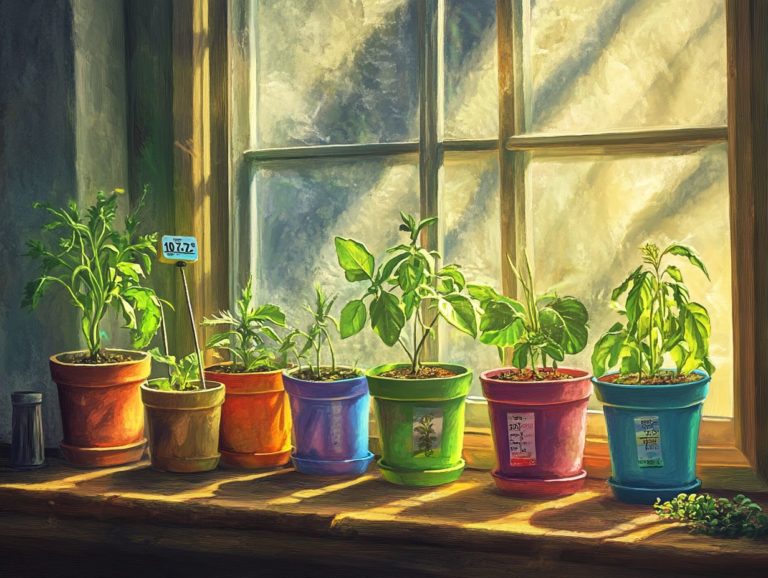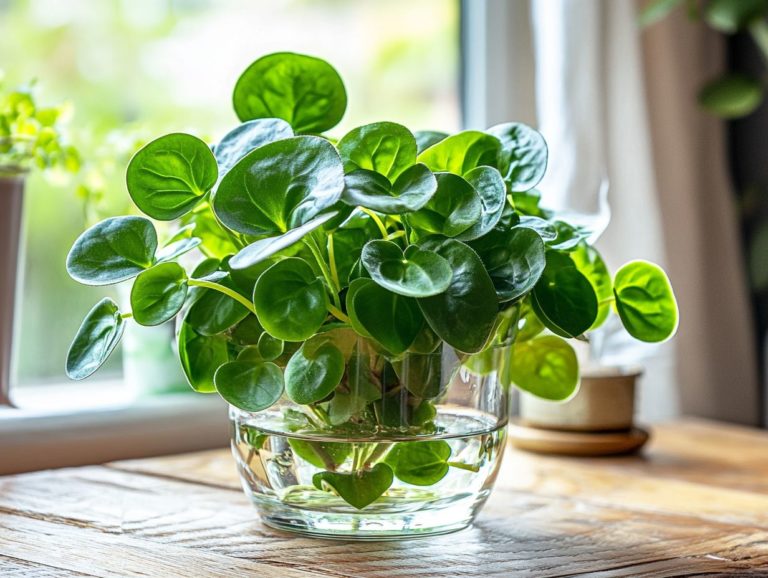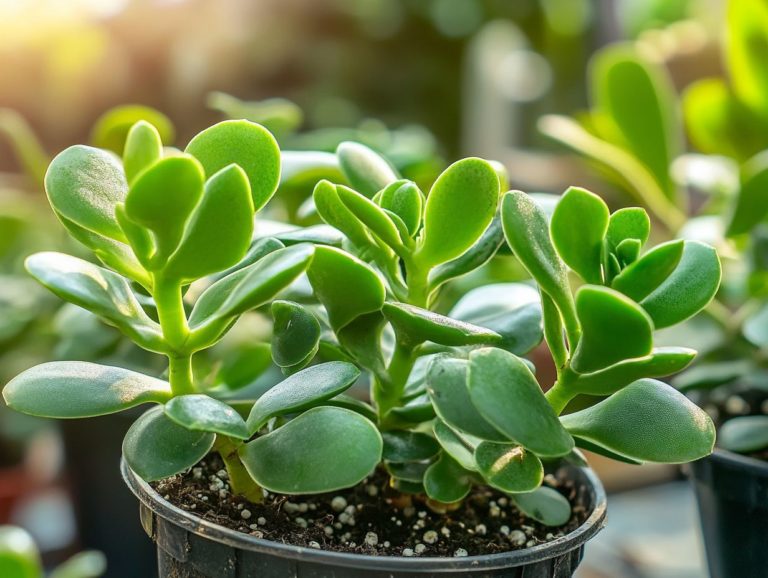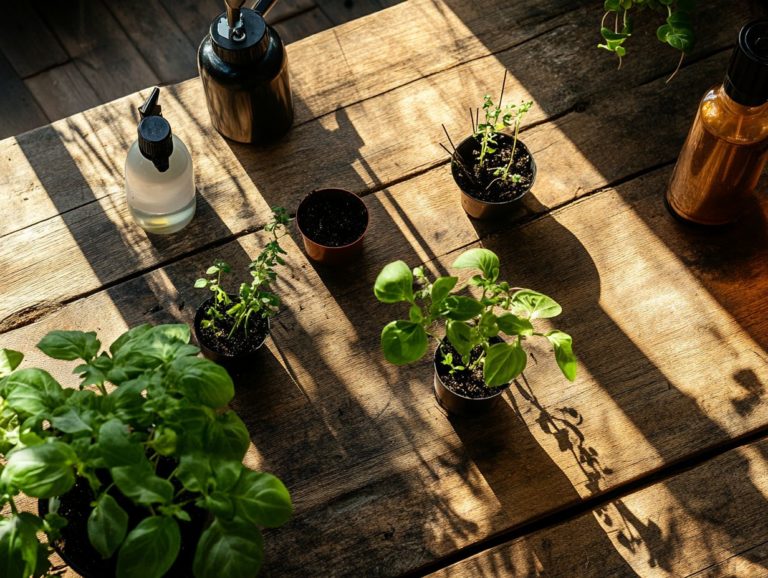Propagating Plants: Water vs. Soil
Are you eager to expand your indoor garden or breathe new life into your plant collection? Mastering the art of plant propagation can unlock an exciting array of possibilities. Get ready to elevate your gardening skills!
This article delves into two popular methods: water and soil propagation. You ll also find guidance on determining which method aligns best with your needs. Curious about which method suits you best? Prepare to cultivate your green thumb!
Contents
- Essential Takeaways for Propagating Plants!
- What is Plant Propagation?
- Water Propagation
- Soil Propagation
- Which Method is Best?
- Troubleshooting Common Issues
- Frequently Asked Questions
- What is the difference between propagating plants in water and soil, especially regarding water roots and soil roots?
- Which method is better for propagating plants: water or soil?
- Are there certain plants that are better suited for water propagation?
- Can all plants be propagated in soil?
- How often should I change the water when propagating plants in water?
- Can I switch a plant from water propagation to soil propagation?
Essential Takeaways for Propagating Plants!
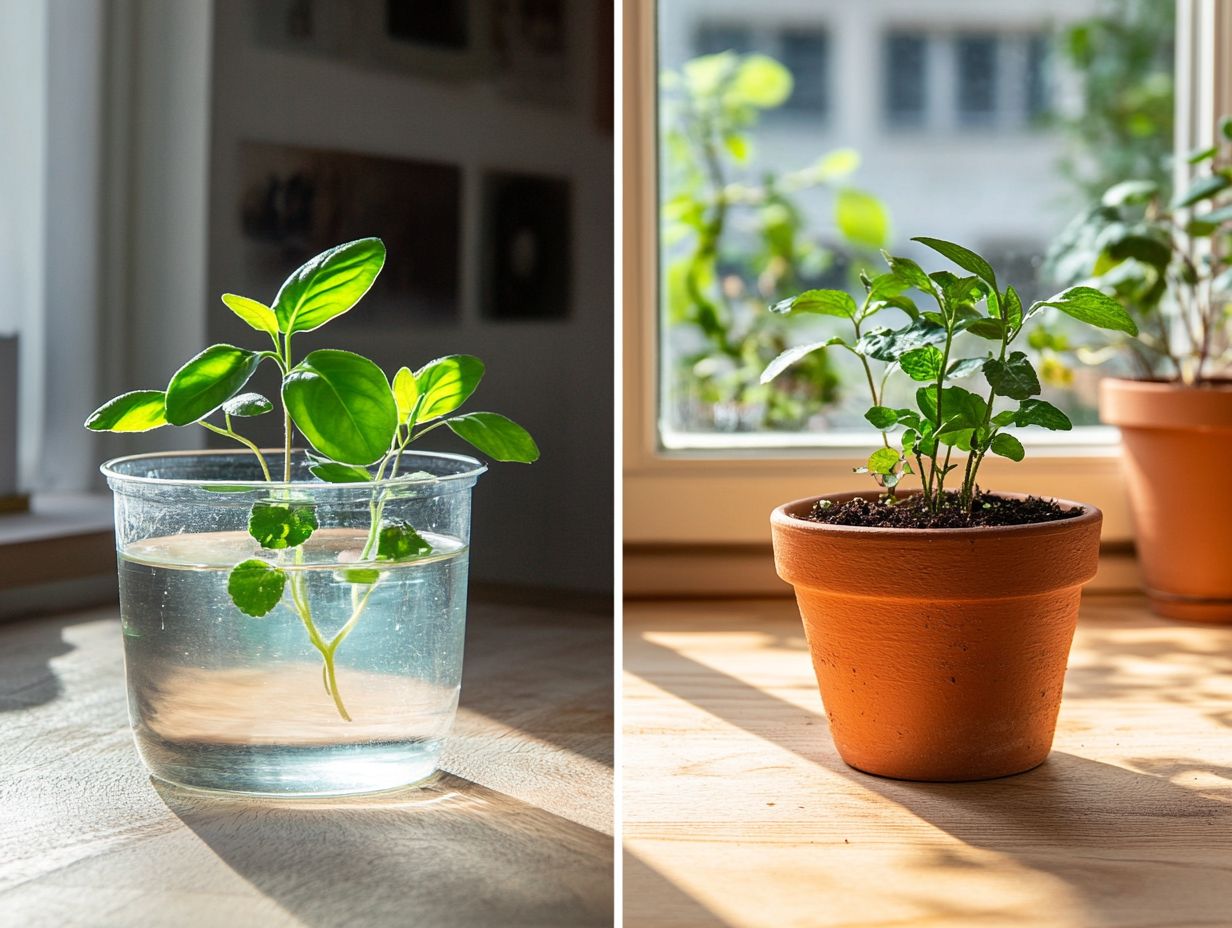
- Water propagation is a simple and efficient method for propagating plants, but it may not be suitable for all types of plants.
- Soil propagation can be more challenging, but it allows for better root development and a higher success rate.
- The best method for propagating plants depends on various factors such as the type of plant, availability of materials, and personal preference. Consider these factors when deciding which method to use.
What is Plant Propagation?
Plant propagation is both an art and a science. It enables you to create new plants from existing ones through methods such as water propagation and soil propagation.
This essential gardening technique allows you to expand your indoor plant collection while cultivating a vibrant environment. It also nurtures strong roots and healthy saplings.
Commonly practiced with popular species like Ficus lyrata, ZZ plants, and Monstera, propagation provides practical benefits in your gardening endeavors. Watching cuttings transform into thriving plants brings emotional satisfaction.
Water Propagation
Water propagation is an elegant and visually captivating technique. You place plant cuttings in water to encourage root growth. This method is perfect for beginners and offers a front-row seat to the fascinating process of root development.
This approach often leads to strong roots that are ready for a seamless transition into soil. To ensure your success, pay close attention to light conditions and regularly monitor water levels, as these factors are crucial for optimal growth.
How to Propagate Plants in Water
To propagate plants in water, start by selecting healthy cuttings from your parent plants. Be sure to remove excess foliage that could rot. Place the cuttings in suitable propagation vessels filled with clean water.
This method works wonders for species like pothos or heartleaf philodendron, as they tend to develop strong roots that thrive once you transplant them into soil.
Once you’ve chosen your cuttings, use a vessel that allows you to monitor the water level and root development easily. Clear glass jars or containers are ideal for this purpose. Ensure the lower bumps where roots grow are submerged, but be cautious not to let any leaves touch the water, as that can lead to rot.
Change the water every few days to keep it fresh and oxygenated, creating an optimal environment for those new roots. As time passes, you’ll notice the cuttings sprouting roots, which can take anywhere from a few weeks to several months, depending on the plant species.
Watch their health and growth. When the roots reach a length of about two to four inches, you’ll be ready to transfer them to soil, giving your plants the best chance to flourish in their new home.
Start propagating today and watch your plant family grow!
Benefits and Drawbacks
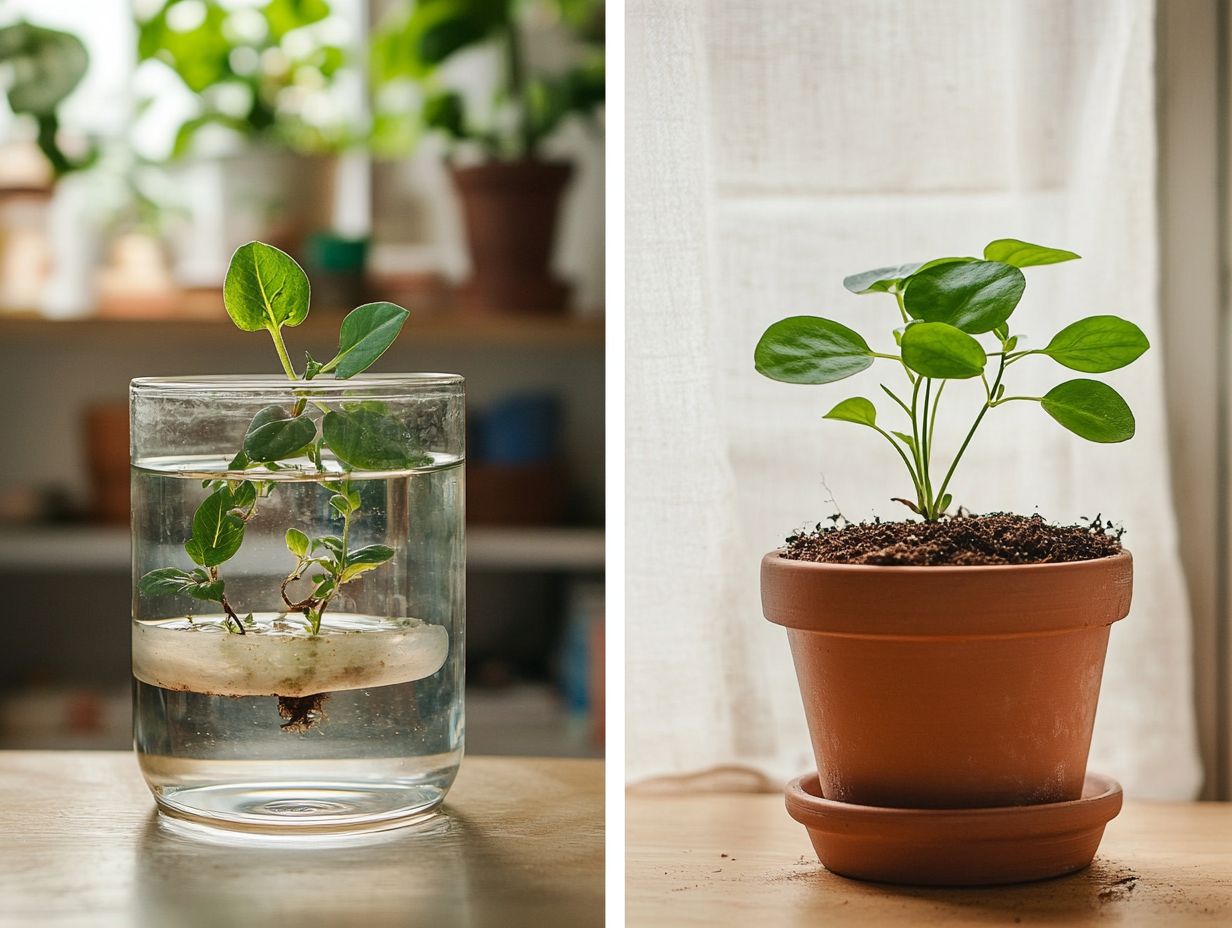
Water propagation has many benefits. You can easily see root growth, and it’s simple to do, making it popular among gardening fans.
However, it has some challenges. You need to monitor water levels closely, as stagnant water can cause roots to rot.
One big plus is the minimal equipment required. A simple glass container works well, and you can see progress without disturbing your plants.
But be careful using tap water can introduce harmful chemicals.
Using filtered or distilled water greatly improves root development. Regularly changing the water prevents algae buildup and keeps your plants healthy.
With the right care, like choosing strong cuttings and giving them good light, this method can lead to thriving plants eager to grow in soil.
Soil Propagation
Soil propagation is a favorite for many gardeners. It helps roots grow strong in the very medium where plants will flourish.
This method makes it easy for new plants to adapt when they are moved to the soil.
How to Propagate Plants in Soil
Start by preparing your cuttings properly. Use a special powder to help roots grow, then place them in moist soil.
This technique works particularly well for cuttings from Aroids and Begonias, as they thrive in soil.
Choose healthy, disease-free stems that are 4 to 6 inches long. Make your cut just below a node to encourage new growth.
After applying rooting hormone to the cut ends, prepare a potting mixture that keeps moisture but drains well.
Once your cuttings are in the soil, mist the area to keep humidity up. Place your setup in a warm spot with indirect light.
Check moisture levels regularly keep the soil damp, but not soggy, for the best chance at strong root systems.
Pros and Cons
Soil propagation has many advantages. It allows roots to grow strong in a stable environment, often resulting in healthier plants.
However, challenges exist, such as the risk of transplant shock and uncertainties in root establishment.
One of the best parts of soil propagation is the natural support it provides. Soil helps young plants absorb nutrients and stay firmly in place.
Pay close attention to soil quality and moisture levels. These factors significantly influence root development.
By monitoring conditions closely, you can reduce the risk of transplant shock.
Developing strong root systems is exciting, but being aware of possible challenges is key. Addressing these issues makes soil propagation a reliable part of your gardening strategy.
Which Method is Best?
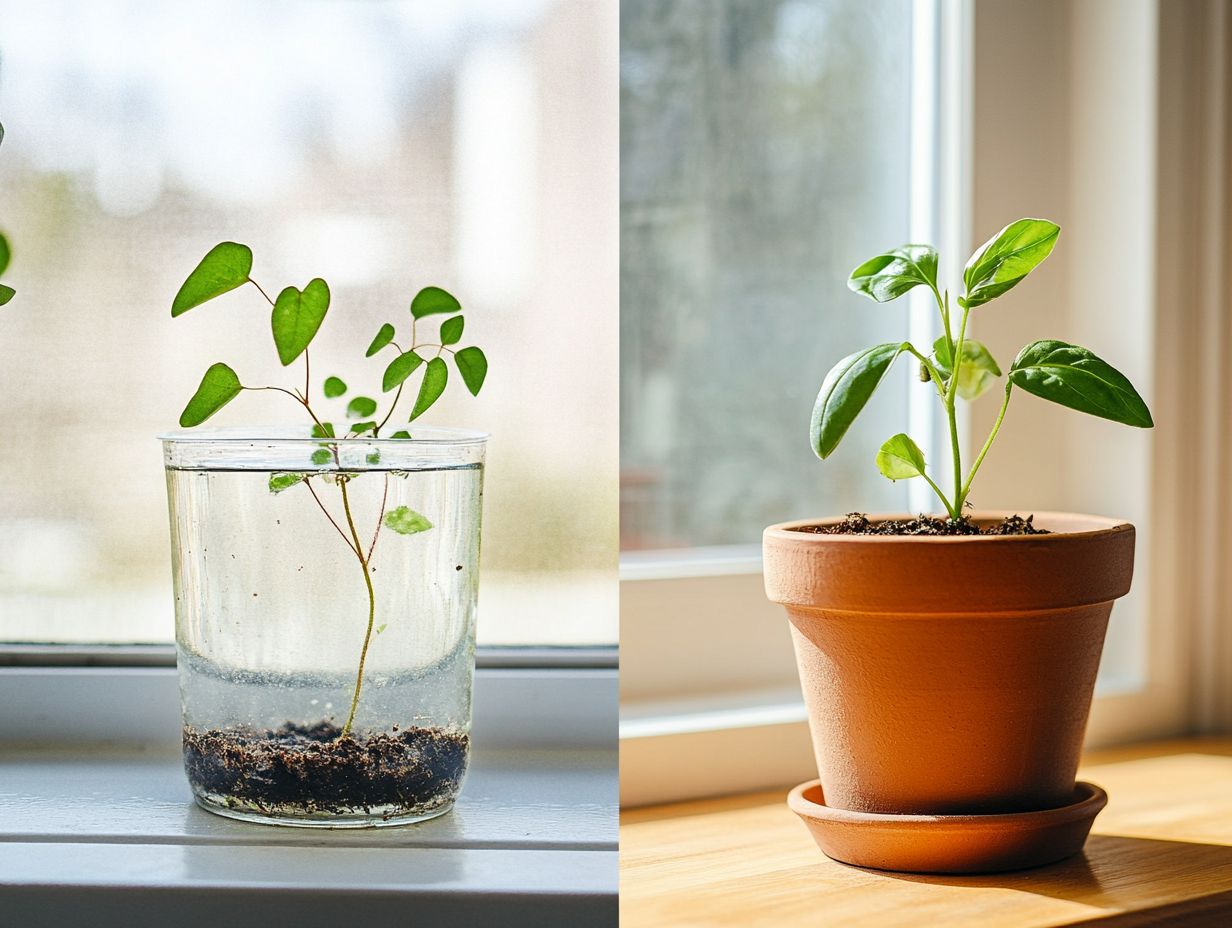
Selecting the ideal propagation method often depends on the specific plant type and your personal gardening preferences. Water propagation and soil propagation each offer distinct advantages for nurturing healthy roots and thriving plants.
As a beginner, you might find water propagation appealing for its simplicity and ease of monitoring growth. In contrast, seasoned gardeners may prefer soil propagation, appreciating its potential for long-term rewards in plant health and vitality.
Factors to Consider
When selecting the best propagation method, consider several key factors. These include the specific light conditions needed for your plant type, the suitability of each method, and your own comfort level with monitoring water levels or soil moisture.
Along with light, the natural characteristics of the plant are crucial in determining the most effective growing method. Some species thrive in bright, indirect sunlight, while others flourish in lower light levels. This can influence your choice of techniques such as cuttings, layering, or division.
Your gardening expertise plays a significant role; if you’re a novice, you might prefer simpler methods that require less precision. More experienced gardeners may opt for advanced techniques to achieve better success rates.
Understanding these factors boosts your chances of success and leads to a more vibrant garden!
Troubleshooting Common Issues
Troubleshooting issues in plant propagation is essential for achieving healthy roots and successful growth. Many gardeners face specific challenges that can hinder root establishment and plant vitality.
Recognizing these common mistakes can transform your propagation experience and lead to thriving plants.
How to Address Common Problems
To effectively tackle issues in plant propagation, it s vital to recognize signs of distress, such as yellowing leaves or stunted growth. These symptoms may indicate propagation errors or environmental factors that need your attention.
By observing these signs closely, you can identify underlying causes and take necessary steps to fix them. For instance, if you suspect overwatering, adjusting your watering schedule and ensuring proper drainage can help prevent root rot, setting the stage for the vigorous growth you want during propagation, especially when monitoring water levels in your propagation vessels.
Tweaking light conditions can help, whether by moving your plants to a sunnier spot or providing them with shade. Maintaining optimal temperature and humidity levels is equally crucial for creating an environment that nurtures healthy root formation and overall plant vitality.
Frequently Asked Questions
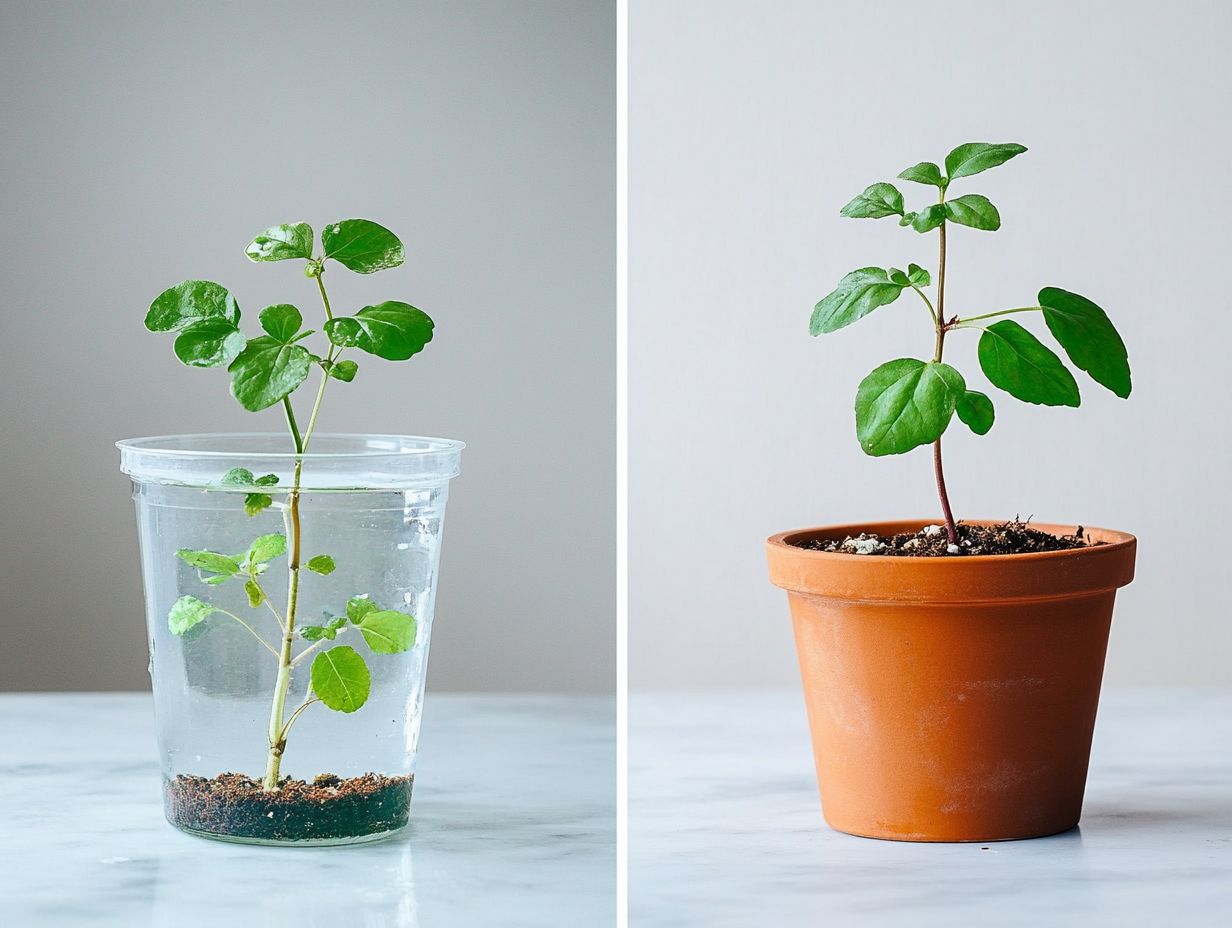
What is the difference between propagating plants in water and soil, especially regarding water roots and soil roots?
Propagating in water involves placing a plant cutting in a container of water to grow roots, while propagating in soil means planting the cutting directly in soil and providing it with adequate moisture and nutrients. Water roots typically grow in water, absorbing moisture directly, while soil roots develop in the soil, exploring for nutrients.
Which method is better for propagating plants: water or soil?
There is no clear answer, as both methods have their benefits. Water propagation is convenient and lets you see roots grow, while soil propagation provides necessary nutrients and can promote faster growth.
Are there certain plants that are better suited for water propagation?
Yes, plants with soft stems, such as pothos and philodendron, are ideal for water propagation. They typically root quickly and easily in water.
Can all plants be propagated in soil?
No, not all plants can be propagated in soil. Some plants, like succulents, are better suited for soil propagation, while others, like begonias, may not root as easily in soil.
Jump into the exciting world of plant propagation today try both water and soil methods to see which one suits you best!
How often should I change the water when propagating plants in water?
Change the water every 2 to 3 days. This helps prevent bacteria growth and ensures your plant gets enough oxygen for strong roots.
Can I switch a plant from water propagation to soil propagation?
Yes, you can! Once your plant has a healthy root system, take it out of the water. Gently plant it in soil and give it proper care and moisture for successful growth.


